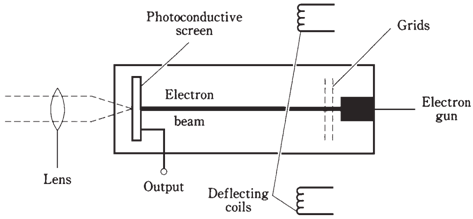The vidicon
Virtually every videocassette recorder (known as VCR) makes use of a vidicon camera tube. Closed circuit TV systems, like the kind you see in convenience stores and banks, also use the vidicon. The basic advantage of vidicon is its small physical bulk; it is easy to carry around.In vidicon, which may be as small as a photo camera, a lens focuses incoming image onto the photoconductive screen. The electron gun generates an electron beam which scans across the screen by deflecting coils, in a similar manner to the operation of the electromagnetic cathode ray tube(CRT). The scanning in vidicon is synchronized with the scanning in picture tube which displays the image seen by the camera tube.As the electron beam scans photoconductive surface, the screen gets charged. The rate of discharge in some of the region on the screen depends on the intensity of visible light falling on that region. A simplified view of the vidicon tube is illustrated in the figure given below.

Figure--Simplified cutaway view of a vidicon camera tube.
A vidicon is sensitive, working well in dim light. But its response becomes sluggish when level of illumination is quite low. This makes images to persist for a short while. You may have noticed this when using a VCR in a dimly lit environment. The motion “smears” and images blur.